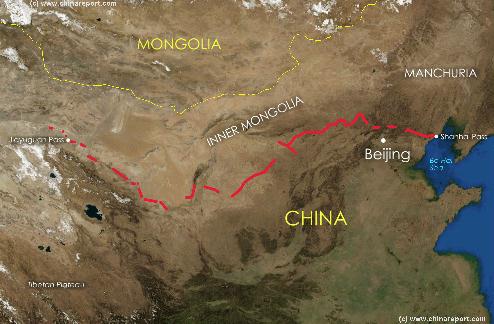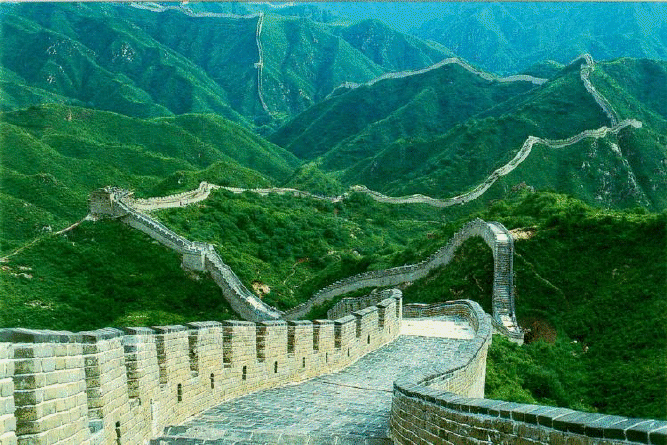 The
Great Wall of China, one of the greatest wonders of the world, was
listed as a World Heritage by UNESCO in 1987. Just like a gigantic
dragon, the Great Wall winds up and down across deserts, grasslands,
mountains and plateaus, stretching approximately 8,851.8 kilometers
(5,500 miles) from east to west of China. With a history of more than
2000 years, some of the sections are now in ruins or have disappeared.
However, it is still one of the most appealing attractions all around
the world owing to its architectural grandeur and historical
significance.Chinese Name: 长城/万里长城
The
Great Wall of China, one of the greatest wonders of the world, was
listed as a World Heritage by UNESCO in 1987. Just like a gigantic
dragon, the Great Wall winds up and down across deserts, grasslands,
mountains and plateaus, stretching approximately 8,851.8 kilometers
(5,500 miles) from east to west of China. With a history of more than
2000 years, some of the sections are now in ruins or have disappeared.
However, it is still one of the most appealing attractions all around
the world owing to its architectural grandeur and historical
significance.Chinese Name: 长城/万里长城Chinese Pinyin: Cháng Chéng/Wàn Lǐ Cháng Chéng
Length: 8,851.8 km (5,500 miles)
Construction Period: About 2,000 years from the Warring States Period (476 BC - 221 BC) to Ming Dynasty (1368-1644)Source: http://www.travelchinaguide.com/china_great_wall/
A first set of walls, designed to keep Mongol nomads out of China, were built of earth and stones in wood frames during the Qin Dynasty (221-206 BCE).
Some additions and modifications were made to these simple walls over the next millennium but the major construction of the "modern" walls began in the Ming Dynasty (1388-1644 CE).
The Ming fortifications were established in new areas from the Qin walls. They were up to 25 feet (7.6 meters) high, 15 to 30 feet (4.6 to 9.1 meters) wide at the base, and from 9 to 12 feet (2.7 to 3.7 meters) wide at the top (wide enough for marching troops or wagons). At regular intervals, guard stations and watch towers were established.
Since the Great Wall was discontinuous, Mongol invaders had no trouble breaching the wall by going around it, so the wall proved unsuccessful and was eventually abandoned. Additionally, a policy of mollification during the subsequent Ch'ing Dynasty that sought to pacify the Mongol leaders through religious conversion also helped to limit the need for the wall.
Through Western contact with China from the 17th through 20th centuries, the legend of the Great Wall of China grew along with tourism to the wall. Restoration and rebuilding took place in the 20th century and in 1987 the Great Wall of China was made a World Heritage Site. Today, a portion of the Great Wall of China about 50 miles (80 km) from Beijing receives thousands of tourists each day.
Source: http://geography.about.com/od/specificplacesofinterest/a/greatwall.htm
 |
Location Map - Great Wall of China |
The Great Wall of China is a series of fortifications made of stone, brick, tamped earth, wood, and other materials, generally built along an east-to-west line across the historical northern borders of China in part to protect the Chinese Empire or its prototypical states against intrusions by various nomadic groups or military incursions by various warlike peoples or forces. Several walls had already been begun to be built beginning around the 7th century BC; these, later joined together and made bigger, stronger, and unified are now collectively referred to as the Great Wall. Especially famous is the wall built between 220–206 BC by the first Emperor of China, Qin Shi Huang. Little of that wall remains. Since then, the Great Wall has on and off been rebuilt, maintained, enhanced; the majority of the existing wall was reconstructed during the Ming Dynasty.
Other purposes of the Great Wall have included border controls, allowing the imposition of duties on goods transported along the Silk Road, regulation or encouragement of trade and the control of immigration and emigration. Furthermore, the defensive characteristics of the Great Wall were enhanced by the construction of watch towers, troop barracks, garrison stations, signaling capabilities through the means smoke or fire, and the fact that the path of the Great Wall also served as a transportation corridor.
The Great Wall stretches from Shanhaiguan in the east, to Lop Lake in the west, along an arc that roughly delineates the southern edge of Inner Mongolia. The most comprehensive archaeological survey, using advanced technologies, has concluded that all the walls measure 8,851.8 km (5,500.3 mi). This is made up of 6,259.6 km (3,889.5 mi) sections of actual wall, 359.7 km (223.5 mi) of trenches and 2,232.5 km (1,387.2 mi) of natural defensive barriers such as hills and rivers.
Source: http://en.wikipedia.org/wiki/Great_Wall_of_China



No comments:
Post a Comment